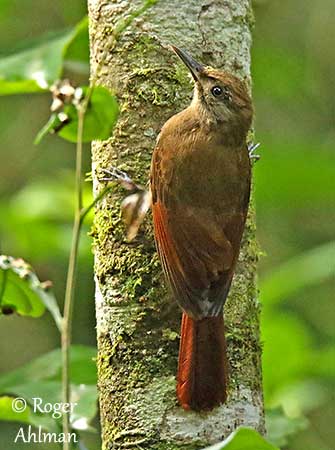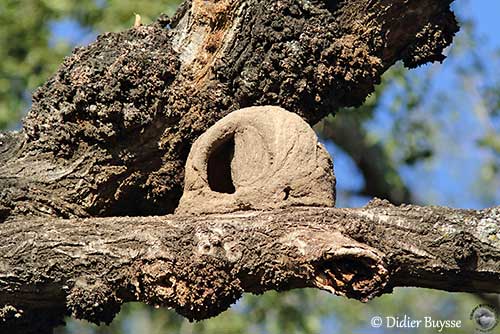
TO BE CONTINUED... Page 4
Text by Nicole Bouglouan
Photographers:
Roger Ahlman
Pbase Galleries Peru and Ecuador
John Anderson
John Anderson Photo Galleries
Didier Buysse
Vision d’Oiseaux
Eduardo Andrés Jordan
MIS AVES – AVES DE ARGENTINA
Philippe and Aline Wolfer
OISEAUX D'ARGENTINE
These images and the text are subject to copyright and cannot be used without express authorization from the owners. Legal issues
Sources:
HANDBOOK OF THE BIRDS OF THE WORLD Vol 8 By Josep del Hoyo-Andrew Elliott-David Christie - Lynx Edicions - ISBN: 8487334504
BIRDS OF SOUTH AMERICA – Passerines - by Robert S. Ridgely and Guy Tudor – HELM Field Guides – ISBN: 9781408113424
A GUIDE TO THE BIRDS OF MEXICO AND NORTHERN CENTRAL AMERICA by Steve N. G. Howell, Sophie Webb - Oxford University Press - ISBN: 0198540124
A GUIDE TO THE BIRDS OF COLOMBIA by Steven L. Hilty and William L. Brown - Princeton University Press – ISBN 069108372X
Animal Diversity Web (University of Michigan Museum of Zoology)
Wikipedia, the free encyclopaedia
CREAGUS@Monterey Bay (Don Roberson)
The bird and its nest, where everything starts…
Second part: The Passerines – Order Passeriformes
Page 3: Furnariidae (Ovenbirds)
At the beginning of the breeding season and following several courtship displays, the nest-site is selected by the pair, or one of the members of the pair, and the nest is built within this area. For numerous species, the nest is the place where displays and copulation occur. It plays a very important role during the nesting period. It is the cradle of the chicks, the place where the adults feed them prior to their first flight towards independence.
The family Furnariidae (ovenbirds) is a New World family found in the neotropics. The name of the family comes from its main genus “Furnarius” and probably alludes to the peculiar shape of the nest, an adobe mud structure fairly similar to an oven. However, this nest type is actually very unusual within the family, but all the members draw a particular attention to the nest shape, often distinctive and surprisingly large.

The ovenbirds share a general appearance with mostly brown plumage, usually conspicuously streaked, with throat patches, wing stripes and tail patches. The tail is long and often graduated, described as “spiny” in some species.
In order to compensate for the lack of bright colours, numerous ovenbirds have complex plumage pattern making them very attractive. Some species such as the Pearled Treerunner show this type of plumage.
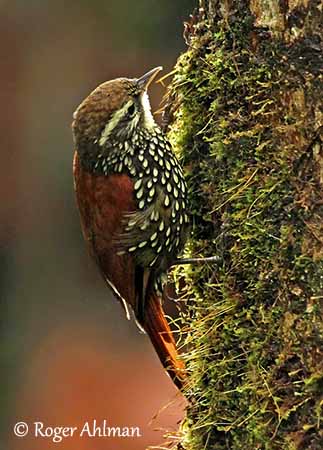
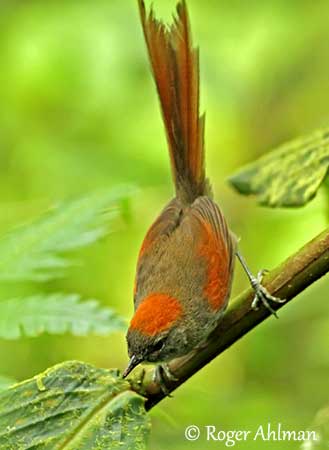
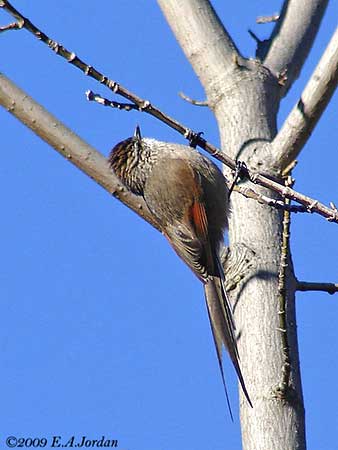
The ovenbirds display a wide range of bill shapes, associated with their behaviour. The long, slightly decurved bill (nearly straight) of the Straight-billed Earthcreeper is adapted for searching between rocks or in crevices from where the bird extracts insects, including eggs and larvae.
In the same way, the tail shape may vary between the genera. It is also related to the foraging behaviour, when the bird uses it as a brace while climbing. The wings are relatively short, rounded to pointed, due to their sedentary status and lack of aerial foraging.
Male and female are fairly similar, with only subtle differences between them and the female slightly paler than the male. They have unmusical and often harsh voices.
The juveniles often have an ochraceous wash on the underparts, dusky feather edges involving scaly appearance on throat and breast, and reduction or absence of throat and crown patches.
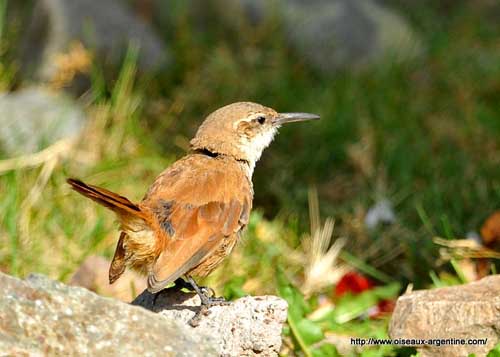
The family Furnariidae is found from Mexico and Central to South America. They frequent a wide variety of habitats, and can be found from the highest elevations in the Andes all the way down to lowland Amazonia. They occur from wet cloudforest to virtually rainless desert, but also in river-island mudflats, coastal sand dunes and saltwater marshes. They are also present in almost all human-made habitats, from urban parks to degraded pastures.
Two species, the Seaside Cinclodes and the Peruvian Surf Cinclodes are living in the rocky intertidal area, a truly marine environment. The Blackish Cinclodes from Falkland Islands, is fairly abundant along coastal rocky or sandy beaches, and usually found in the vicinity of colonies of seabirds and marine mammals.
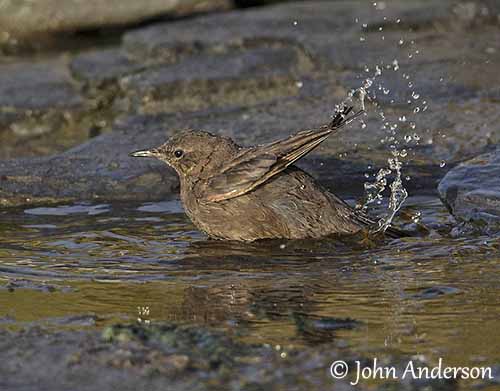
Ovenbirds feed mainly on invertebrates, and primarily arthropods. But the birds of genus Cinclodes which are restricted to aquatic habitats and shorelines have a diet dominated by intertidal invertebrates, fairly similar to that of shorebirds such as Scolopacidae. The treehunters of genus Thripadectes catch small frogs and lizards, but no mammals or birds have been reported as prey items. Seeds and fruits are part of the diet of several species.
The foraging behaviour varies depending on the genus. They search for prey in bark, epiphytic vegetation and branches, dead leaves suspended above the ground, also in leaf litter or on the bare ground, and between rocks or in crevices.
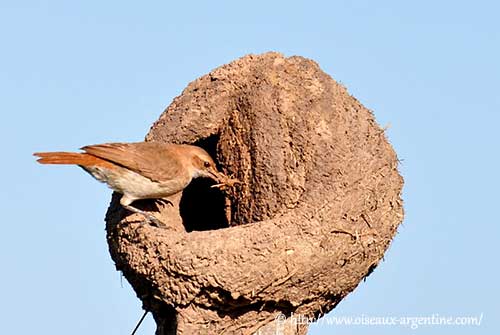
The members of the family Furnariidae breed when insects are available. They usually breed during the austral spring and the summer months, but also during the wet season, depending on the range.
The dull plumage coloration of Furnariidae indicates that monogamy is by far the most common breeding system. The pair-bonds are suspected to persist beyond a breeding season in numerous species, even if some of them become solitary after the season.
The courtship displays are poorly known, and information on the roles of male and female during the breeding cycle is missing. But absence of sexual plumage dimorphism indicates that both adults probably share the nesting duties.
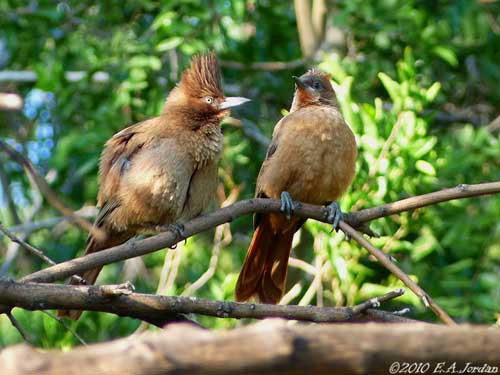
The Furnariidae show a great diversity and complexity of nest types, nonexistent among other bird families.
The best known is the nest of the Rufous Hornero. This nest may weight up to 5 kg whereas the bird weighs about 50 grams. Such construction requires a lot of energy in collecting, transporting and molding mud and straw.
The Rufous Hornero is known for its wonderful oven-shaped nest. This large spherical nest is made with clay, mud and vegetation such as straw. It is large with 20 to 30 cm in diameter, and 20 to 25 cm high. The walls are about 3 to 5 cm thick. Such structure can weight 3 to 5 kg. The walls made with mud and plant material or dung, become very hard once dry. It is the typical “adobe” technique. The nest is placed up to 8 metres above the ground, and usually situated on exposed tree branch or any suitable structure, or sometimes on the ground in bare areas.
The structure is divided by a wall which separates the entrance from the nest-chamber, somewhat reminiscent of a snail shell. The orientation of the entrance may be variable, and it is often positioned contrary to wind or rainfall direction, but not always. Some nests have two entrances whereas others have only a top entrance.
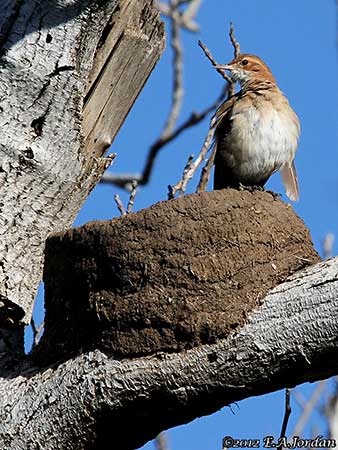
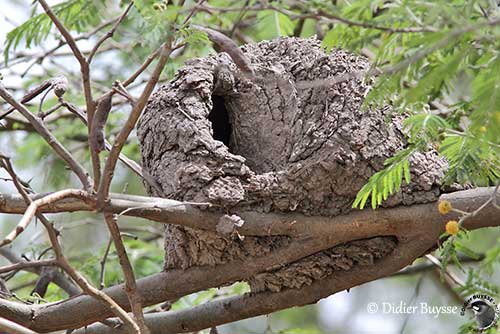
The second nest-type category includes nests placed inside a cavity such as abandoned woodpecker hole or natural hollow. Species of genera Pygarrhichas and Xenops may occasionally excavate their own nest in soft wood.
The Thorn-tailed Rayadito nests in cavities in trees, dead snags, behind loose bark or in crevice in the trunk, and sometimes under roofs. The nest is made with rootlets and stems of epiphytic vines and grasses. The interior is lined with feathers.
The cavity-nests are often burrow-shaped, a horizontal tunnel in a vertical or steep earth bank, in order to restrict the access to the nest by predators. Between others, the members of genus Cinclodes are known to excavate their own tunnel, but they also nest in natural crevices in rocks, cliffs and even buildings. They sometimes use burrows excavated by other animals, such as the Blackish Cinclodes that uses the burrows of diving-petrels.
These nests are generally lined to receive the eggs. Several materials can be used, such as wood chips, tree-fern scales, sticks, stiff feathers of larger birds, grass, leaves, strips of bark, rootlets, vegetal down and spider webs.
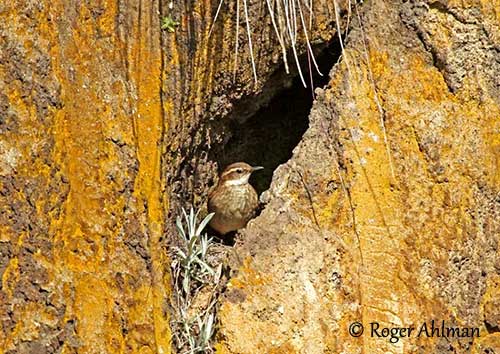
The third nest-type category is a domed structure made with plant material. The entrance is on the top, bottom or side and leads to the nest-chamber. The nests made with sticks are most common, and mainly with thorny sticks when available. But wire or barbed wire may be incorporated into the nest. These nests are the largest and the most conspicuous of all types, with little or no attempt to conceal them. They can be repaired during the breeding season. They are built at the end of a branch, or in cactus or other thorny vegetation, and usually repel predators.
The Greater Thornbird builds a bulky, cone-shaped structure made with twigs and sticks, often thorny ones. There is a side entrance at lower level, leading to the nest-chamber, and occasionally to an antechamber. The nest-chamber of 10-12 cm in diameter is lined with soft materials such as fine grasses and feathers.
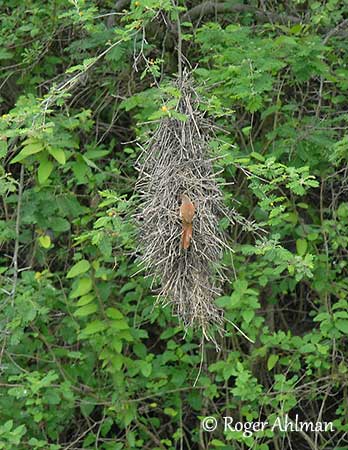
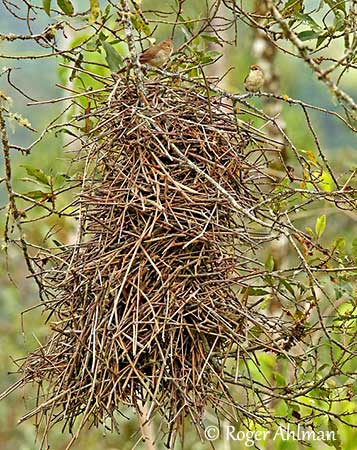
The variation in nest architecture among these birds is exceptional, but the main goal it to protect both eggs and chicks from predators. In addition, such amazing structures also provide a protection from bad weather, heat and cold, aridity and rainfall, mist and high winds.
The eggs laid within cavities or domed nests are typically white whereas others may have some bluish, greenish or buff tinge, but patterned eggs are not recorded. The clutch size varies with the habitat and the range and may vary from a single egg to 2-3 or up to 5 or more eggs. The incubation ranges from 14 to 22 days, according to the size of the bird.
The chicks are altricial. They are usually fed by both parents and the nesting period lasts from 13 (smaller species) to at least 29 days in larger species.
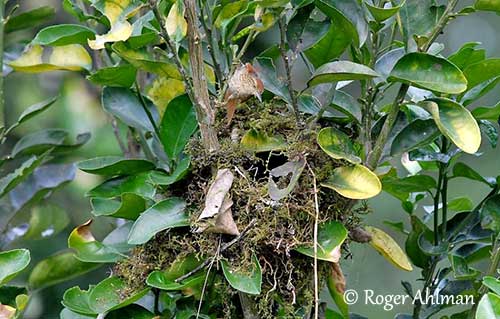
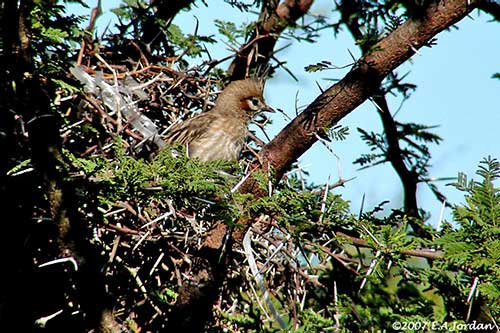
But in spite of such elaborated structures, several predators are able to reach the nest. These predators include snakes, Guira Cuckoo, Roadside Hawk and Black-chested Buzzard-Eagle that are able to extract the chicks from the nests.
They also suffer competition for nest-sites with introduced species such as House Sparrow, and the nests are parasitized by the Shiny Cowbird.
Ovenbirds are threatened by habitat destruction through deforestation, burning, grazing and agriculture expansion that involve fragmentation of ovenbird habitat.
The members of the former family Dendrocolaptidae, known as woodcreepers, are now included in the family Furnariidae, due to their close relationship. Genetic data support this position.
The woodcreepers are found in the Neotropical Region and range from Mexico south to central Argentina. They live in lowland tropical rainforest, but some species frequent forest edge habitats, semi-open habitats, cloud forest, savanna or arid scrub. They are visible from below 1,000 metres up to 3,600 metres of elevation. They can be found in urban areas too.
They are small to medium-sized birds. They have brown, olive or rufous plumage with white spotting, streaking or barring. They have usually rufescent, broad, rounded wings and long tail with rigid, claw-like shafts. The specialized tail helps the birds to climb trees, like the legs and feet with strongly decurved claws.
The bill is adapted to the foraging behaviour, and can be long or short, thick or thin, straight or decurved, depending on the species.
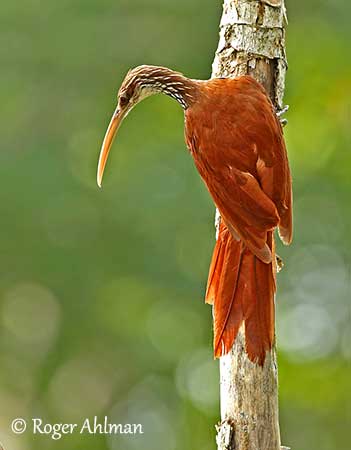
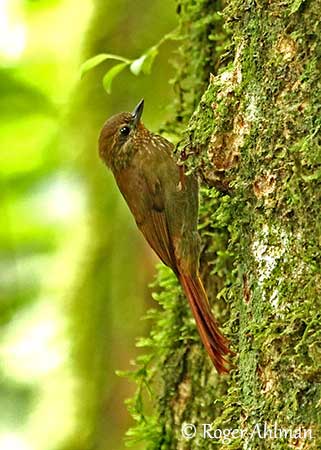
Most of them are not sexually dimorphic, but some males are larger than females, with longer, erectile crown feathers.
The juveniles have more barred plumage, a shorter tail and a darker, shorter bill.
The Woodcreepers search for food in a manner typical of woodpeckers. They forage while creeping up tree trunks or along the largest branches. They glean prey from the bark surface or probe into crevices, vine tangles, clumps of moss, bromeliads and various epiphytes. Some species living in open habitats forage on the ground through the leaf litter.
They are mainly insectivorous and their diet includes grasshoppers and crickets, beetles, cockroaches, ants, spiders, and some species may also take lizards. Other insect species are taken in smaller quantities.
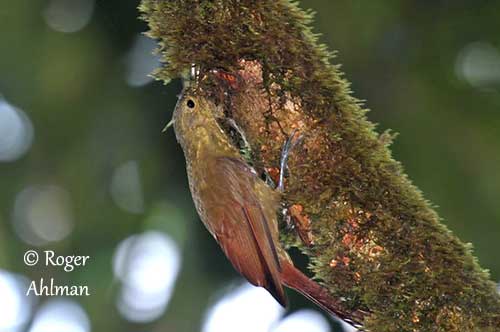
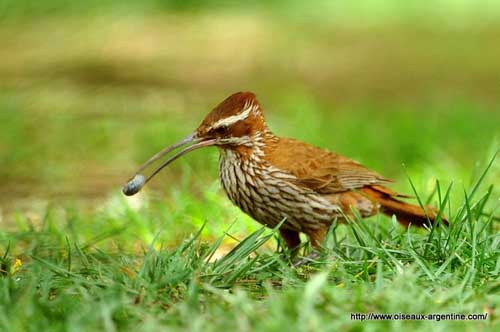
The breeding biology of woodcreepers is poorly known. The larger species appear to be socially monogamous with pair-bonds maintained throughout the year, and both adults share the nesting duties. On the other hand, the members of genus Dendrocincla and probably some other species do not have long-term pair-bonds and may use leks.
All woodcreepers nest in cavities and lay typically white eggs in a shallow cup or on bark flakes or wood shavings. The nests are placed in a variety of cavities such as cavities in rotting trunks or hollow created by a broken branch. But they also use abandoned termite nests, or nest between roots, among vine tangles or at base of palm fronds.
There is no evidence that they excavate their own nests, but they may enlarge the entrance. They use abandoned woodpecker holes, or even abandoned nest of Rufous Hornero. Most nests are placed between 5 and 10 metres above the ground but mainly 5 metres, whereas the entrances of some nests are just above the ground. In a few instances, the nest cavities are subterranean. The nest entrance is often long and narrow and the adults have to contort the body when entering. Some nests have an entrance at the top, and the birds are not protected from the rain.
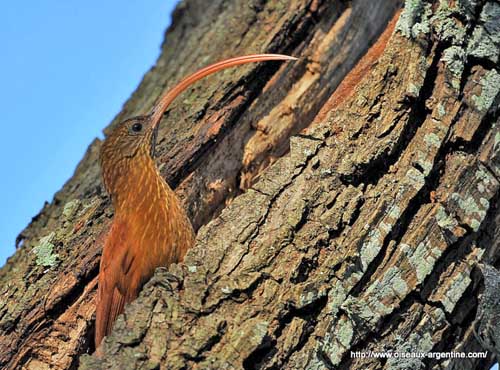
The clutch usually contains two white eggs, occasionally three or only one. Both adults incubate but the female seems to do most of this work. Limited information is available about the incubation period. The shortest lasts 14 days with a nestling period of 21 days but the species of genus Dendrocincla require longer incubation. The chicks are generally fed by both parents. The fledging young remain with the parents for long period, but no more a few months.
Like numerous species, the woodcreepers are threatened by fragmentation and destruction of the habitat for agriculture expansion, logging, mining and increase of urban areas. The reduction in lowland forest also causes the reduction of the army ants colonies that reduces the foraging success of many species of woodcreepers.
